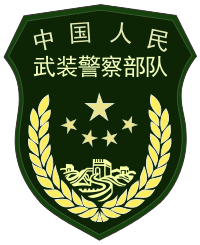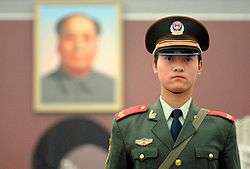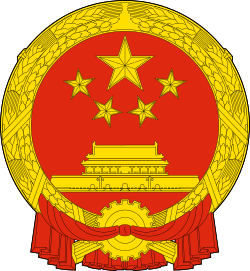People's Armed Police
| Chinese People's Armed Police Force (PAP) 中国人民武装警察部队 (武警) | |
|---|---|
|
Badge of the People's Armed Police | |
| Active | June 19, 1982 - Present |
| Country |
|
| Branch | State Council and Central Military Commission |
| Type | Gendarmerie |
| Role | Preservation of Public Order and Security, Civil Defence, Reserves, Engineering Projects |
| Size | 1.5 million |
| Garrison/HQ | Beijing, Haidian District, China |
| Colours | Red, Green |
| Commanders | |
| Commander | General Wang Ning |
| Political Commissar | General Sun Sijing |
| Insignia | |
| Armband |
 |
| Emblem of PAP Helicopters |
 |
| Emblem of PAP Forestry Troops Helicopters |
 |
The Chinese People's Armed Police Force (abbreviated: PAP;[1] simplified Chinese: 中国人民武装警察部队; traditional Chinese: 中國人民武裝警察部隊; pinyin: Zhōngguó Rénmín Wǔzhuāng Jǐngchá Bùduì or Chinese: 武警; pinyin: Wǔjǐng in short) is a Chinese law enforcement force primarily responsible for civilian policing and fire rescue duties in the People's Republic of China, as well as providing support to the PLA Ground Force during wartime.
In the contrast to public security police PAP servicemen, also called as "Armed Police soldiers" (武警战士), wear olive green instead of the blue uniforms of the Public Security Police . From January 1, 2005 to July 31, 2007 the position had been renamed 'internal guard' (内卫) with arm insignia reflecting this change; new uniforms issued on August 1, 2007 carried the term for "People's Armed Police" (中国武警).
The PAP is estimated to have a total strength of 1.5 million.
History
The history of the People's Armed Police is as long as that of the People's Republic, and its origin can be traced back to the People's Liberation Army, which was responsible for both defending the nation from foreign invasions and internal security. Although the force was officially established in 1982, its constituent units stretch back to 1949.[2] After the establishment of the People's Republic of China, it was soon apparent that the different troops were required for the vastly different missions, and the domestic security functions had to be removed from the People's Liberation Army. As a result, the portion of People's Liberation Army responsible for internal security and other domestic police missions branched out to form the Public Security Army, under the administration of the Ministry of Public Security of the People's Republic of China. Although under the Ministry of Public Security, the Public Security Army troops were not exactly public security police officers because in addition to regular police work, they were also tasked with secondary military tasks which was not part of the responsibility of regular police officers of the public security ministry.
After numerous name changes and reorganization, the PAP was created on June 19, 1982 by an amalgamation of the PLA's border control, security units and fire department, as well as from Ministry of Public Security units. The establishment of the People's Armed Police marked the effort to professionalize the security apparatus, as well as the absorption of numerous PLA demobilized personnel,[3] in the wake of a growing unrest.[4]
Until 2013 the China Coast Guard was a part of the PAP, but it was separated, since then it reports directly to the Ministry of Public Security and the State Oceanic Administration.
Mission

The People's Armed Police's primary mission is internal security. The first law on the People's Armed Police, the Law on the People's Armed Police Force (PAPF), was passed in August 2009, giving it statutory authority to respond to riots, terrorist attacks or other emergencies.[5][6] Such units guard government buildings at all levels (including party and state organisations, foreign embassies and consulates), provide security to public corporations and major public events, as well as counter-terrorism and handling of public emergencies.[7] Some units perform guard duty in civilian prisons and provide executioners for the state. The PAP also maintains tactical counter-terrorism (CT) units in the Immediate Action Unit (IAU), Snow Wolf Commando Unit (SWCU) and various Special Police Units (SPUs).
The PAP maintains division sized mechanized infantry unit and a rapid deployment light motorised infantry unit , these units are tasked with responding to any possible armed mutinies by PLA soldiers. In times of war, PAP can act as light infantry supporting the PLAGF in local defence missions.[8]
Organization
.jpg)
The People's Armed Police has a dual command structure including the Central Military Commission (CMC) and the State Council through the Ministry of Public Security. By law however, the PAP operates separately from the PLA.[9]
In terms of conducting public security operations and relevant capability building, the PAP Headquarters is under the leadership and command of the Ministry of Public Security
Although their uniforms (olive green) and insignia are different from those of the PLA, PAP guards wear military-style uniforms and insignia that often leads to them being mistaken for PLA.[10] Furthermore, due to its history with the PLA, the PAP has a similar rank structure to the PLA and also obeys its regulations. PAP guards are also recruited at the same time and through the same procedures as PLA soldiers. However, the PAP has its own education and training system separate from the PLA. Like the PLA, the PAP also celebrates Army Day on August 1 of every year, and enjoys the same services as the PLA.
Top-level organization
The People's Armed Police Headquarters is the leading and commanding organ that directs and administers all the units and provides guidance to it. The PAP has a commander, a political commissar and several deputy commanders and deputy political commissars.[11] The PAP also has departments responsible for logistical and political matters and several speciality departments
Territorial organization
The People's Armed Police is composed of contingents at the level of the province (autonomous region or municipality directly under the central government) and armed divisions. Divisions, Detachments and squadrons are established at the province, prefecture, and county levels, respectively; all units depend on the relevant party committee and government level. Using the national information infrastructure, the PAP has established a preliminary system of three-level integrated information networks, linking general headquarters with the grass-roots squadrons.[11]
The divisions are further downsized to regiments, battalions and companies in battle order, which are stationed in a number of provinces, autonomous regions and municipalities directly under the headquarters. The PAP Headquarters has an educational institution directly under it. All the contingents have elementary command colleges under them.[11]
The "environmental" forces (gold mines, forestal and hydropower units) have a role into technical projects, while the highway and road security specialty is in charge of highway maintenance and construction, as well as emergency rescue and disaster relief operations.[11]
Border security forces
People's Armed Police border security forces (Simplified Chinese: 边防部队; pinyin: biānfáng bùdùi) guard China's land and sea borders, as well as its ports and airports. Its main responsibilities are the administration of border and coastal public security, ports and border inspection and surveillance, performing patrols and surveillance activities in areas adjacent to Hong Kong and Macao, as well as patrols and surveillance activities along the demarcation line of the Beibu Gulf and the prevention of and crack-down on illegal and criminal acts in border and coastal areas, such as illegal border crossing, smuggling and drug trafficking.[7]
The border security force deploys:[7]
- 30 contingents in the Provinces of China (except Beijing);
- 110 detachments in border and coastal prefectures and 20 marine police detachments in coastal prefectures;
- 207 active-duty border inspection stations at open ports;
- 310 groups in border and coastal counties;
- 1,691 border police substations in border and coastal townships;
- 46 frontier inspection stations on major border routes;
- 113 mobile groups deployed in important sectors in border areas.
Special Units
See also
References
- ↑ "武警使用新的英文简称PAP". 超级大本营. Retrieved 2016-05-08.
- ↑ Shambaugh, David L. (2004). Modernizing China's military: progress, problems, and prospects. University of California Press. p. 170.
- ↑ Guo, Xuezhi (2012). China's Security State: Philosophy, Evolution, and Politics. New York: Cambridge University Press. pp. 228–229.
- ↑ Guo, Xuezhi. China's Security State: Philosophy, Evolution, and Politics. p. 229.
- ↑ Top legislature passes armed police law. China Daily. August 27, 2009.
- ↑ Wines, Michael (August 27, 2009). China Approves Law Governing Armed Police Force . The New York Times.
- 1 2 3 "Armed Police Force". Ministry of National Defense. Retrieved 22 September 2015.
- ↑ Blasko, Dennis J. (2006). The Chinese Army today: tradition and transformation for the 21st century. Routledge. p. 87.
- ↑ Blasko (2006), p. 18.
- ↑ 栾, 尚林 (2005) 武警统一佩戴新式臂章胸标含义及使用范围 (The People's Armed Police new arm patches and badges and their uses). Xinhua.
- 1 2 3 4 "V. People's Armed Police Force". Retrieved 22 September 2015.
_cap_insignia.svg.png)
